| Years | 1991 World Championships (Lt 2x 5th) 1992 World Championships (Lt 4- 2nd) 1993 World Championships (Lt 4- 1st) 1994 World Championships (Lt 4- 2nd) |
| Clubs | North Shore RC (New Zealand), Nottinghamshire County RA |
| Height | 5’7.5″ or 171.5cm |
| Born | 1966 |
The photo at the top of this page shows Alison Brownless, Jane Hall, Annamarie Dryden and Tonia on the medal podium after winning the lightweight coxless fours at the World Rowing Championships in 1993 and is from Alison Purnell’s personal collection.
Getting into rowing
Tonia only started rowing in ‘fine boats’ when she was a student, but had spent her childhood messing about in – and racing all sorts of boats from dinghies to surf skis (a type of sit-on kayak) – on the sea near her home in Auckland, New Zealand.
Having also swum competitively at school, when she went started studying architecture at university in 1984, “I was a bear with an itch I suppose; I needed to do something to channel my energies because I was fairly exuberant and a bit obnoxious if I didn’t use some excess energy,” she explains. A colleague of her dad’s, who was a member of the local North Shore Rowing Club, invited her to give it a try, although initially she was put in the coxing seat because she was quite small. “I proceeded to just thrash the girls in the boat by shouting, ‘More!,’ and so perhaps someone realised I was quite competitive because when they next put a novice crew together, I ended up in the boat and then I kind of refused to get out really.”
Although she didn’t realise it at the time, she was in the right place at the right time. “North Shore RC had produced an awful lot of the Olympic and World Championship male rowers, though they were just reaching the tail end of all those male successes when I arrived,” she say. “But then, in my second year rowing, Jane Stanley, who was married to one of those internationals and was a teacher at a local school, brought a whole load of kids in who went through to be the next generation of successful international rowers at the club, both openweight and lightweight, so although they were a year or two younger than me they were good, local ‘shore’ girls and we had a whale of a time!”
In 1988 Tonia was selected to stroke the first New Zealand women’s eight to race internationally. The driving force behind the crew was Stephanie Foster (the first woman to row for New Zealand at an Olympic Games, in the single sculls in 1984) who got sponsorship that allowed them to race in an invitation event at the Brisbane Expo.

The 1988 New Zealand Universities eight, most of whom were from North Shore RC. (Photo: Tonia Williams’ personal collection.)
That year Jane Stanley also encouraged the selectors to give Tonia a trial for the Under-23 team too although, she says, “It was a bit of a token trial because I was seat raced against Philippa Baker (who had been the lightweight single sculler at the 1987 World Championships) but it was an interesting experience nevertheless.”
Tonia spent six months living and rowing in Switzerland in 1989 and raced at Lucerne regatta in a single with, as she says, “puddles of fear” radiating off her boat as she lined up on the start a fairly novice sculler against the current world champion. While she was in Europe she also went to watch the World Championships in Bled which, she explains, “Was a rare opportunity for a Kiwi rower to see what the world standard was like. “When you’re in New Zealand it can feel like the world stage is huge and way above the standard you’re at, but seeing it for myself, it suddenly didn’t seem so daunting.”
Back home, Tonia trialled for the senior team in 1990, when the World Championships were ‘next door’ in Tasmania, but was unimpressed with the way the team was being run. “Philippa got left on the bank that year,” Tonia explains. “She and Linda de Jong had won the silver medal at the Worlds in 1989 in the lightweight double, and she really wanted to race the single in 1990, but the selectors (who were all former openweight male internationals) wanted her and Linda to row with me and another girl in the lightweight four. They gave Philippa a ‘It’s the four or nothing’ choice, so she chose ‘nothing’. The other two did a double, and I felt that was my cue to leave New Zealand and to pursue my rowing ambition in the UK, especially as I’d finished my architecture degree and the Kiwi building industry was going through a recession, so there wasn’t anything to keep me there work-wise.”

Tonia racing in the Premier (Elite) Single Sculls at the New Zealand National Championships in 1990 when she was the only lightweght to make the final. (Photo: Tonia Williams’ personal collection.)
Moving to Britain
Although Tonia had grown up in New Zealand (her parents were Welsh and Cornish), she’d actually been born in Britain, and therefore had dual nationality. “Not long after I was born, Mum and Dad had got to the point where they were looking for new opportunities, and they looked at three options: South Africa which they dismissed because they weren’t sure it was a safe place to bring up a young family at that time, Canada and New Zealand,” she explains. “New Zealand replied first, and Dad got whisked out there to be Dominion Breweries’ chief architect which meant that he was designing hotels and pubs all around the country, and Mum and I followed on a flight which I think took about 32 hours, with various fuel stops along the way.”
When she decided she wanted to move back to Britain to row, she followed a relatively well-trodden path to Nottingham established by various male Kiwi rowers. “I faxed my rowing CV to Ian Wilson, who was the coach at Nottinghamshire County Rowing Association [a centre of excellence for men’s lightweights at the time – Ed.],” Tonia remembers, “And Ian loved the underdog so of course he just said, ‘Come, we’ll look after you.’ I’m forever grateful to him even because even though the guys had paved the way, he was very open to some foreign chick coming in and just borrowing gear and wanting to do stuff, although I think my British passport presented Ian with an appealing opportunity to add diversity to the Nottingham lightweights’ ‘Let’s have a go at London’ thing all over again [if you don’t understand this reference, it’s way beyond the scope of this site to explain it, though you could roughly think of it as a ‘north/south divide – Ed.] without me even being aware of that at all!”
Tonia arrived in Nottingham one weekend in May 1990 and met up with the rowers on the Sunday evening. “I remember Ian wagging his finger at me and saying, ‘There are however many thousand men in Nottingham, you can date any of them so long as they’re not a rower!’ and I replied, ‘That’s OK, what makes you think I’m interested in rowers anyway?'”.Within a week, helped by a business contact of her parents’ who kindly lent her an office, a phone and a car so she could cold call local architecture practices and go to interviews, she’d found somewhere to live, a boat and bike to borrow, and to support all of that, got a job with a local architects practice.
She wasn’t NCRA’s only serious woman rower, though. There was also Rachel Hirst, who had been the GB openweight single sculler at the Under-23 Match des Seniors in 1986 and 1987, and had then gone lightweight and rowed in the coxless four in 1989 (winning silver) and 1990, despite the crew being based in London. “We overlapped more in the winter because in the summer she was travelling down south a lot to row in the four,” Tonia remembers. “But she was the trailblazer who showed that it was possible to live in Nottingham and row in a London-based GB crew,” she’s quick to emphasise. More on this shortly.

Tonia stroking the first NCRA crew to race at the Women’s Head in 1991 where they finished fourth. Other current or future GB internationals in the crew are Rachel Hirst (6), Gillian Lindsay (5) and Helen Mangan (4). Shauna McGibbon, a lightweight triallist in 1990 who was a squad doctor, is at bow. (Photo: Tonia Williams’ personal collection.)
International rowing career
1991
Tonia first appeared on the GB international rowing scene at the first assessment in February 1991, where she was the equal fastest lightweight sculler in the first run. “I remember this gaggle of lightweight women scanning the results sheet and they were all going, ‘Who is this Tonia Williams?’ because it semed like I’d just landed from Mars and no one knew who I was. So I just smiled and walked past and didn’t say anything!”
“The squad registration form asked you to tick a box to say whether you wanted to be considered for sweep or sculling, but I ticked both,” she says. “I was quite keen on sculling but I also wanted to knew where I’d come in the mix in the sweep group, although I didn’t really want to commute to London because I’d seen how hard it was for Rachel.”
She raced in a scratch GB lightweight four at Ghent, the first regatta of the 1991 season, but after that decided to form a double with Claire Parker, who lived in Warwick but also trained in Nottingham. “I liked the idea of getting a crew together early and then training in it to make it faster,” Tonia explains, “And I really enjoyed the contrast with the New Zealand situation where there were middle aged men telling women what crews they were going to be in. That year in the UK there were about five lightweight women’s doubles, all vying for that slot, and all out there racing each other in good, open honest, fair competition, and whoever was fastest would really deserve to go and would know they’d earned it. The camaraderie amongst those lightweight doubles was brilliant. Nicky Dale and Lizzie Holmes must have been gutted when we beat them at Lucerne but I think they were chuffed to bits for us as well, and to me that was pure sportsmanship.”
Tonia and Claire were duly selected as the GB lightweight double and finished fifth at the World Championships. Although part of Ian Wilson’s overall setup, they were coached by the sculler Simon Larkin, who was able to give them undivided attention, although she remembers him disappearing from time to time when they were on their final training camp in Varese to indulge his enthusiasm for hang gliding. “Simon was a disciple of square blade finishes,” Tonia remembers, laughing, “Which was quite demanding, so if we were going out for an afternoon paddle and we realised he’d gone off hang gliding, we’d dash to get out on the lake so we could get a session in without being nagged about our finishes!”
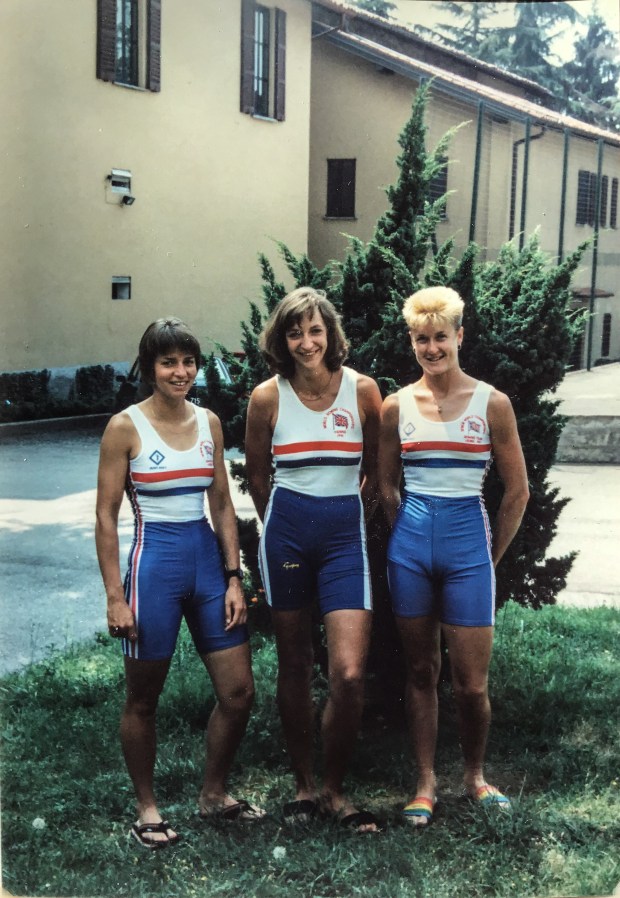
The three NCRA members in the 1991 GB women’s rowing team in Varese. From left: Claire Parker, Rachel Hirst and Tonia. (Photo: Tonia Williams’ personal collection.)
Making weight
Although Tonia was racing lightweight, she was quite tall and making weight was hard for her. In New Zealand she’d rowed with some much lighter women so had only needed to get down to the personal maximum of 59kg, rather than the crew average of 57kg. “I had to be under 57kg on the first day at the Worlds because Claire wasn’t sure if she was going to make it, and seeing 56 point something on the scales was a bit frightening!”
1992
In 1992 Tonia switched back to her ‘first love’, sweep rowing, a decision that took a little time to form and was shaped by multiple factors. The lightweight four had won a silver medal at the 1991 World Championships, but by the early part of 1992 its stroke, Katie Brownlow, had joined the openweight eight for the Olympic Games, so there was a clear vacancy. Meanwhile Tonia’s 1991 doubles partner Claire Parker had had to stop rowing because her husband had serious health problems.
Tonia had a medical challenge of her own to overcome too. “After the world Championships I’d been out running one weekend with a friend and had to keep throwing up in the bushes,” she remembers, “I eventually finished up in hospital where they diagnosed an abscess on my appendix, but they decided not to operate. Then, when I was home in New Zealand for Christmas and my sister’s wedding, Ian Wilson phoned to let me know that Bill Mason (the coach of the lightweight four) had been in touch and wanted me to have a go at being in the four, and said, ‘I’ve told him that you’re on weight and you’ll be fit and fabulous when you get back!’ So I ended up having my appendix out privately by keyhole surgery in New Zealand, which was the best investment I ever made because that flaring up would have been a disaster.”
Rowing in the London-based four involved considerable challenges, though. First, there was the commuting, which was not only time consuming and expensive, but also mentally and physically draining. Tonia remembers Ann Redgrave, the GB rowing team doctor, telling her that each journey was equivalent to a training outing, which significantly increased the load on her. Second, she admits she’d put on a lot of weight while she was in New Zealand. “I was probably 67kg or so, and there was pressure on me all the time about that,” she recalls. There was also an inevitable ‘three plus one’ thing which all four members of the crew remember; three members from the 1991 boat plus Tonia, three from London plus one from Nottingham, three who were on weight plus one who wasn’t, and to an extent Tonia’s personality was just different from that of the others too. Tonia’s stroking style was also different from Katie Brownlow’s. “I’d been very clear to Billy that if I was going to be in the boat, I wanted to sit in the stroke seat, so all of those things took a little bit of time to settle down to settle into but I loved it, sweep was my happy place,” she reflects.

Bill, Annamarie, Alison (known as Wilma) and Tonia have a spot of lunch between outings. (Photo © Claire Rimmer.)
The four got the silver medal at the World Championships in Montreal that year, after leading the race until the last 80m when they were rowed down by the Australians, a particularly painful twist for Tonia because of the natural rivalry between “Kiwis and Aussies”.
She adds, though, “I was furious because my weight had been such a big issue all through the season but in the end there were other things that I think contributed to us being rowed down.” These included Tonia not having a rate meter so she couldn’t check the stroke rate she was setting when she wanted to, and switching to the new hatchet-style blades very late in the season and so only having very limited time to experiment with how to gear these (all rowers were struggling with this as there was very little data available full stop, never mind for lightweight women’s sweep crews who were particularly few in number. “As a result, when I started the 1993 season my mindset was quite different. I’d felt that matters beyond my control had influenced the 1992 result after I’d been made to feel all season that my weight was a big issue, and so I was determined to actually probably be a little more difficult and a little bit less complicit with some things, because by then I’d had a year in the four and I‘d seen that not every decision was perfect and wanted to be part of making better decisions.”
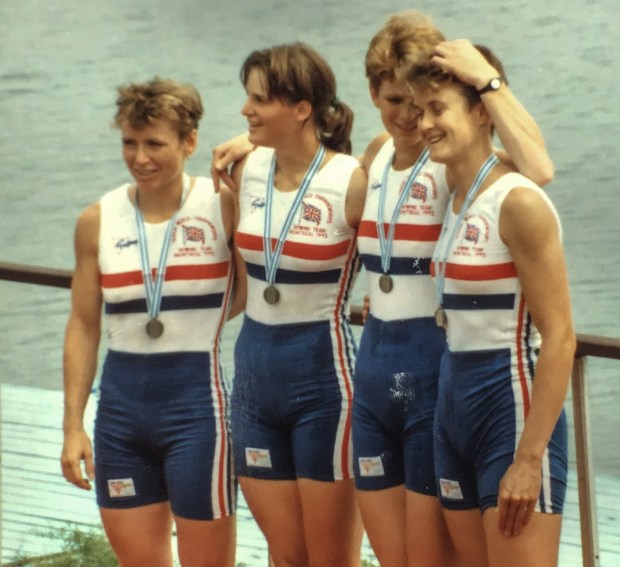
“Silver sucked.” Annamarie gives Tonia a sympathetic hug after receiving their medals. (Photo: Tonia Williams’ personal collection.)
1993
By 1993 the ‘three plus one’ feeling had subsided somewhat; there had been new shared experiences, and Jane Hall replaced Claire Davies in the crew which altered the dynamics and the ‘old crew versus new crew’ balance. Tonia got on particularly well with Jane, about whom she says, “We had a lot of fun.”
There was also time to do more experimenting with gearing, and, “We’d got a bit more sensible about my weight management and actually put some science behind it so there was a plan that I’d only get down to weight by the racing season,” she adds, “So everything was a bit less controversial and more enjoyable.” The London/Nottingham divide remained though, “But I bought a better car, and I sucked up the cost of the twice-weekly train fares. The traffic could be just pants, and I do remember arriving at the IC boathouse ridiculously late a few times but I had no way of letting anybody know because it was before the days of mobile phones, so that must have been hugely frustrating for the others.” Despite this, Tonia never considered moving to London because not only did she have a good job in Nottingham and liked the water there, she also really disliked the Tideway (the rowing part of the Thames in London). “I’ll never forget the first few times I trained on it because it was bumpy, there were logs, you had to put gumboots on to get into the boat, there were gin palaces, and the water was like the sea!,” she laughs.
Almost everything about the 1993 season went to plan for the eventual crew, and they were able to build on the previous year, winning the gold medal at the World Championships, which was a great triumph for Tonia and the other women in the crew, but was also historically significant it was the first sweep gold medal and only the second gold at all (the first having been in the lightweight double sculls) that British women had won at the World Championships which had first included women’s events in 1974, some 20 year earlier. GB women’s lightweight fours had won silver medals three times since lightweight events were introduced in 1985, but only in 1993 did a crew finally get everything right and conquer the world.

What a difference a year makes. Wilma, Tonia, Bill Mason, Annamarie and Jane after winning gold at the World Championships in 1993. (Photo: Alison Purnell’s personal collection.)
Tonia remembers that she and the crew spent the season and the World Championships “in our own little bubble”, totally focused on the job in hand, but had a lot of fun celebrating once they’d achieved the long-sought result. Straight after the medal ceremony, she was given a New Zealand flag, “And I probably annoyed everybody in the British team by wearing it as a skirt for the rest of the day!,” she says. She also remembers with much amusement being given the opportunity to phone her grandma in Cornwall (as her parents would be asleep in New Zealand at that time) immediately after the crew’s live interview on BBC television. “I’d had some ‘racing stripes’ shaved into the sides of my hair by a bored Greg Searle,” she recalls, “And the first thing Grandma said, in her strong Cornish accent, was, ‘Ere, Tonia, what you ‘m done to yer ‘air?’ which I still find hilarious to this day!”
She also particularly appreciated that the video of the four’s race was played when the Notts County squad gathered for their first training session of the new season in the Autumn. “It was quite special to see that County felt that was a huge thing too,” she remembers, and altogether it was “just great”.
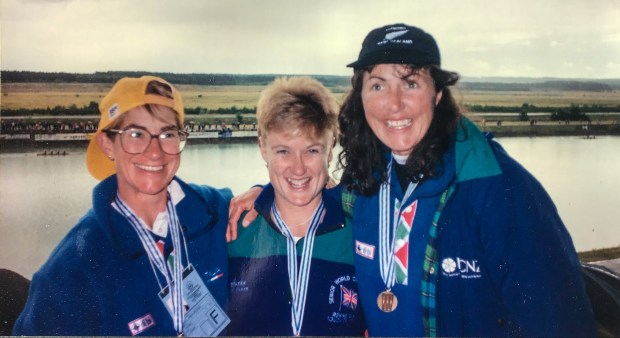
The three 1993 ‘Kiwi’ women World Champions. Philippa Baker-Hogan (left), Tonia and Brenda Lawson. (Photo: Tonia Williams’ personal collection.)
1994
Tonia had no thought of resting on her laurels after becoming World Champion. “I’d looked at the video of the race and thought, ‘What was I DOING? I need to do that better next time!’ and also after straining to achieve something and then getting there, I wanted more,” she explains. “I was really enjoying it, we were going fast, we’d got into that groove that there was more to do really, I think.
The year started well. Tonia, Wilma and Annamarie skipped the British winter, spending most of January and February training in Hong Kong at a well-equipped centre there, which fitted in well with Tonia changing jobs (Jane was a student so couldn’t go). It all started going wrong around Easter time when a previous injury of Annamarie’s flared up putting her out of the boat. Tonia says. “Having come off that camp feeling like we were flying even faster than in 1993, we then found ourselves racing with a revolving cast of ‘super-subs’.” Although they medalled at all of the pre-Worlds international regattas, they didn’t win. “I’m not ‘gonna lie, there were times that year when it felt like a hiding to nothing, and it was pretty hard to stay motivated and focused with so much uncertainty around us,” she recalls. “And this just reinforced the fact that it takes time to build cohesiveness as a crew unit. So there was plenty of pent up emotion in that boat by the time we sat on the start line at Worlds in 1994.”
Annamarie’s rehabilitation programme got her back in the boat in time for them to come third at the Commonwealth Regatta, which they then built on to win the silver medal at the World Championships a few weeks later after an epic row through from fifth to second place in the second half of the race. After everything that had gone on that year, this silver, compared with the bitter disappointment of their 1992 silver, came as a great relief.
Fuller accounts of Tonia’s years representing GB can be read here:
1991 | 1992 | 1993 | 1994
1995
In contrast with her feeling a year earlier, Tonia started the 1995 season with a keen awareness that the ‘lightweight four’ project was over for various reasons; partly they’d done’ that, but more significantly, the 1996 Olympic programme would include an event for lightweight women for the first time, and this was the double scull. On top of that, their coach, Bill Mason, had been appointed to coach a women’s openweight eight for the 1996 Games, and while he undertook to look after the lightweights as well, he certainly wouldn’t be able to give them the amount of attention he had before.
Tonia was therefore eager both to try a new lightweight double and to stop commuting up and down to London. “I guess flatteringly for me, a few people decided they’d come up to Nottingham and scull with me,” she remembers. However, she found the fact that the women’s lightweight double was part of the wider GB Olympic programme to be a mixed blessing because, unlike in 1991 when she’d been able just to get on with her winter training, “We were trialled every month, and kept having to be close to weight as well, which for me was a challenge. So I felt the process was counter-productive to getting into decent units and getting them going fast.”
After a certain amount of mixing and matching combinations early in the season, she was teamed up with Trisha Corless, who lived in Staines near London but was one of the scullers who had been commuting up to Nottingham to train at weekends. For some reason that no one over identified, it just didn’t work, though not for want of trying. “It was definitely a double of two single scullers,” Tonia remembers. “It didn’t gel and so it was always hard work. It was very frustrating.” They didn’t even make the B final at Lucerne Regatta and although they won openweight doubles as well as openweight quads a week later at the National Championships, Tonia decided to call it a day at that point. “After we’d failed miserably at Lucerne, I said, ‘Look, I’m not contributing boat speed, my heart’s not in it, if other crews can go faster, let them try and qualify for the Olympics at the World Championships this year,’ and I took myself off for a break.”
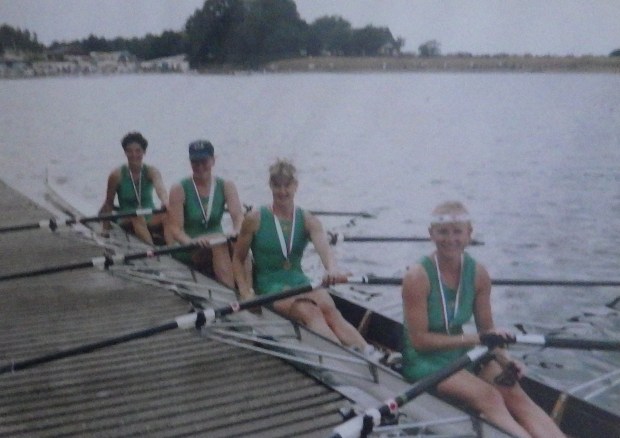
From left: Lucy Hart, Rowan Carroll, Tonia Williams and Trisha Corless after winning openweight quads at the 1995 National Championships. (Photo: Trisha Corless’s personal collection.)
“The double I really wanted to give a go was with Jane,” Tonia reflects, “Because we’d rowed together for several years, she was my ‘weight-make’ because she was very light, and we clicked personally. I think it would have been a fun boat together, so that for me was a regret in not pushing a bit harder to go to Jane and say, ‘Let’s just try this.’ But by then she was doing a pair with Wilma.”
Before she left for a six-month ‘sabbatical’ in New Zealand, Tonia represented Wales at the Home Countries regatta in Cork, racing in openweight single sculls where she was beaten by Rowan Carroll, in openweight doubles with Lucy Hart, and stroking the eight. “It was a fun weekend doing something different,” she says, laughing. “I’d never been to Ireland before and it was an opportunity to drink Irish Guinness too.”
Back in New Zealand where she rowed with the heavyweight squad in Karapiro, being coached by Harry Mahon, whom she’d been coached by in Switzerland in 1989. “I ended up going out in a crew most of the time because there was usually someone was injured or ill, which was a good laugh, and I fell back in love with rowing again,” she recalls. She returned to the UK with the intention of trialling again, although she was uncertain whether she’d be able to make weight after a whole year not dieting. Ultimately, though, her international rowing career ended because her fiancé wanted her to choose between him and rowing (he wasn’t a rower – she’d stuck to the point she’d made to Ian Wilson back when she first arrived in Nottingham about not being interested in dating rowers). “Probably foolishly,” she says, “I decided that was probably time to not diet any more and not row any more. Later I regretted it I think, because I still had a little bit left in me but I’d had a pretty good run and got some hardware!”
Later rowing
Tonia returned to New Zealand for good in 2000 and stayed out of boats for few years but in due course a colleague who was a member of the men’s masters group at North Shore RC, “Heard me mention the word rowing and said, ‘Oh, come on down,’ so I did, but of course they stuck me in the bows of their eight because I was a girl. The rowing was appalling, they were just rowing like sacks of potatoes and so after a couple of outings I couldn’t keep my mouth shut and I made a few suggestions just to try and make it a bit better.” Once the crew finally did their research and worked out who she was, she was promoted to the stroke seat and became affectionately known as Kuini (the Maori spelling for ‘queen’). Notable successes since then include winning mixed doubles with Richard Newey at the world Masters Games in Melbourne in 2002, and coming second at the Head of the Charles in women’s masters doubles with Rebecca Caroe in 2013. She also thoroughly enjoyed winning a clutch of medals at the World Masters Games in Auckland in 2017.

2017 World Masters Games. From left: Rebecca Caroe, Tonia, Philippa Baker, Brenda Lawson, Cheryl Murphy and Linda de Jong. (Photo: Tonia Williams’ personal collection.)
She was President of North Shore RC for six years before “being put out to pasture” as Commodore. “I did that for about 10 years and now I’m just an agitator,” she laughs.
Art and architecture
Throughout all of this she continued to develop her career as an architect. She remembers some of the last work she did in the UK as the most exciting. “We built the Radcliffe Road stand at Trent Bridge cricket ground and we were doing sports centres of excellence in various places which,” she explains, “Was a perfect mix of my sporting and professional interests.”Today, she describes herself as a ‘smarchitect’, and has a passion for designing homes and other buildings with prefabricated panels using Modern Methods of Construction (MMC). She’s recently completed building her own house, and is busy designing and prefabricating homes for many clients.
In 2013 she launched O4rsom Art as an outlet for another blend of her rowing and creative skills. She exhibited some of her paintings at Henley Royal Regatta that year and her greetings cards are usually for sale in its shop, but sadly there is currently no direct supplier of her work in the UK.
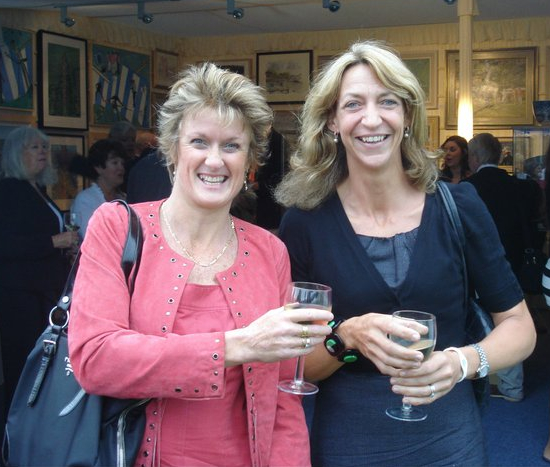
Tonia (left) and her former NCRA clubmate Rachel Stanhope (née Hirst) celebrating the launch of O4rsom Art at HRR in 2013. (Photo: Tonia Williams’ personal collection.)
An O4som commission that she really enjoyed was designing medals for a new, schools regatta in Australia. “They wanted something that would be a bit of eye candy to attract the kids to want to go and race, and it absolutely worked,” she explains, “The kids said that they were a fabulous incentive and I got to go and present them too, so that was great fun.”
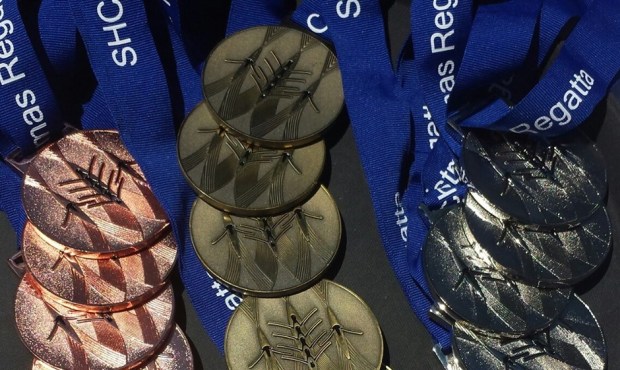
The medals Tonia Designed for the Sacred Heart College Christmas Regatta.
© Helena Smalman-Smith, 2020.
